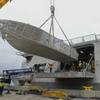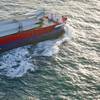Containershipping: When will the Comeback Commence?
Talk about ups and downs. In 2009, the container shipping industry lost US$16 billion. In 2010, it made a profit of $20 billion, and last year was back in the red ink business with an $8 billion loss.
This year? Break even is about the best prediction available even with a surge in freight rates as general rates increases (GRIs) imposed by the carriers in the first few months have largely stuck.
By May, shipping lines on the Asia-Europe trade saw rates surge to 2010 levels with solid spot increases being reported on the transpacific. But the outlook for the rest of the year has industry observers worried. For market analyzing SeaIntel’s Lars Jensen, the problem is straightforward: Too much capacity coming online too fast.
“There is nothing wrong with getting the big ships, but they are coming online faster than the market can absorb them,” Jensen said. “For the next couple of years it is all going to come down to the carriers’ ability to cascade capacity, and also to idle some capacity or accept that they cannot have the utilization they would like. If they can live with the lower utilization levels, rates will stay high, but I don’t know if they can live with it.”
Ship utilization was very much on the mind of Maersk Line’s new head of south China, David Skov. He said shipping lines were realizing that the model of the business was changing.
“In the old days, the most expensive cost was the ownership of your assets and carriers wanted to utilize them to the highest degree possible,” he said.
“But now with bunker fuel being so expensive we are entering a time when the highest utilization may not be the model that gives a liner operator the best economy.
“Lines will have to work out what makes sense. Look at the successful GRIs from March – it makes sense for a ship to sail with a lower utilization of, say, 70 percent at those rates than to sail 100 percent full at the old rates.
“The calculation has to be made by individual lines, but it could be a potential alternative to lay-ups,” Skov said.
But with the drive to regain profitability, the thought of accepting lower cargo loading could be asking too much, and the pressure to deploy vessels of over 10,000 TEUs will grow with the delivery of each ship. Between now and 2014, 80 percent of all the ships that will be delivered will be VLCCs or ULCCs (ultra large container ships), according to Aplhaliner. The market intelligence provider said 26 ships of that size were delivered in the first four months of the year and another 29 will be delivered before the New Year celebrations.
As operating expenses rise, lines are vigorously seeking greater economies of scale to bring down unit costs. Leading this drive is Maersk Line. Next year the first of its 20 EEE series 18,000 TEU ships will float into service.
Ships of this size are limited to operating on the Asia-Europe trade, and as they come online shipping companies have to cascade capacity down to the other trades, keeping rates under pressure.
This profit-sapping surfeit of capacity is giving liner executives grey hairs.
“The boiling overcapacity concern is indeed frustrating the industry, as the global tonnage supply has not been responsibly managed by some shipping lines over the past few years,” said an Evergreen Marine spokesman.
The top Taiwan carrier was one of the few companies to maintain a conservative approach to newbuildings, keeping its orderbook closed for years as competitors pushed theirs out.
However, it now has 35 vessels of 8,800 TEUs on order that will basically see one ship delivered a month for the next three years starting from July this year.
“The ship orders were planned and contracted with proper timing ahead based on Evergreen’s own development scheme, rather than inflaming the rate war when the market was very fragile during the past few years.”
Another line that has chosen to abandon its long-maintained conservative approach to ship orders is Orient Overseas Container Line (OOCL). The Hong Kong-based carrier last year placed orders for ten 13,000 TEU ships at a cost of more than US$1.3 billion. They will be the biggest ships in the fleet when delivered in 2013 and 2014.
Stephen Ng, OOCL director of corporate planning, said the decision to invest in larger vessels was part of the line’s drive to remain competitive while meeting operational efficiency goals.
“Apart from larger vessels that provide better economies of scale, we have also been investing in our box fleets as well as container shipping infrastructure to improve our efficiencies across the operational spectrum so that we can better serve our customers and fulfill their needs,” he said.
Asked whether OOCL was confident the mega ships would be fully utilized, Ng said that would depend on the development of the global economy and the possible phasing out of the older and less efficient vessels, “which are all important factors that are very difficult to predict”.
“OOCL will be working with our partners through the Grand and G6 alliances to maximize the utilization according to what is sustainable on the respective trades where these vessels will be deployed.”
While shipping lines are understandably cautious about expressing their overcapacity concerns and the impact of excess tonnage on rates, most industry watchers have been sounding the klaxons for some time.
Alphaliner, like Jensen, believes carriers are starting to undercut rates.
“Carriers will face a much harder battle to maintain the momentum for further rate increases in the face of rising capacity supply,” Alphaliner said in a report.
The May 1 GRIs, coming after several previous Q1 hikes that increased spot rates on Asia-Europe from $490 per TEU to $1,934 per box, were not well received by shippers.
Alphaliner expects capacity increases to tilt the demand-supply balance against the carriers as demand growth is expected to be flat or mildly negative in the next three months on the trade.
Lines on the transpacific have a different take and expect to see demand for space building through the summer months as retailers stock up on back-to-school items. They are optimistic that 2012 will bring a return of the once traditional peak season for containerized imports into the US and have instituted plans to turn the increased demand into profits via a hefty peak season surcharge (PSS).
A surcharge of $600 per FEU will be imposed from June 15 and is the highest peak levy in five years, equal to 25 percent of the May rate of shipping an FEU from China to the US. It will probably remain in force until October as retailers continue to build inventory for Christmas and the New Year.
Asia-Europe lines are also imposing a PSS, but with the EU in meltdown mode, few believe it will stick.
Transpacific Stabilization Agreement (TSA) executive administrator Brian Conrad said the member carriers saw a strong outlook for the coming months, with utilization already in the 95 percent range. Improving profitability was top of their agenda.
“They continue to dig out after a long period of serious financial losses, and want to be sure they are well-positioned to ramp up services as the trade rebounds,” Conrad said.
The TSA partly based its peak season prediction on positive findings by the National Retail Federation, which show the US economy is on the mend.
“Consumers are spending despite gas prices and other economic concerns, so retailers are stocking up to meet the demand,” NRF vice-president for supply chain and customs policy Jonathan Gold said.
“These numbers show imports growing through the back-to-school season and even into beginning of the shipping cycle for the holiday season. That’s a sign that retailers are expecting a good year.”
The cyclical nature of container shipping means the good years come and go, and the industry will take heart from an HSBC prediction that global trade will grow by 86 percent in the next 15 years.
But no carriers can afford to sit and wait for the good times to return. Rising bunker prices are hiking operating costs and as trade volume slumps, lines have been forced to focus on trimming costs and improving efficiency.
The Evergreen spokesman said as volatility in the business became normal, every incumbent carrier had to be flexible and maintain “a sense of responsibility”, both of which were crucial to long-term sustainability.
“Our strategy is constructive inward rather than offensive outward and we keep all available resources highly utilized through scrupulous cost control or cooperative service partnering to minimize impacts from volatile demands or uprising expenses,” the spokesman said.
OOCL’s Ng said the carrier would leverage its relationships with partners in the Grand and G6 alliances, using larger container vessels on the main trade routes to lower operational costs per slot.
He said the ups and downs over the past 10 years had taught the Hong Kong carrier that it was important to maintain quality services that met the needs of shippers. The line has also invested in its IT systems, allowing the global flow of cargo around the world to be more efficiently managed and to be more visible. Maersk’s Skov said the short-term focus of balancing capacity to demand was the first priority, but long term the real focus of lines had to be how to differentiate them and how to add value to customers in order to capture that elusive sustainable profit.
(As published in the June 2012 "Yearbook" edition of Maritime Reporter & Engineering News - www.marinelink.com)










